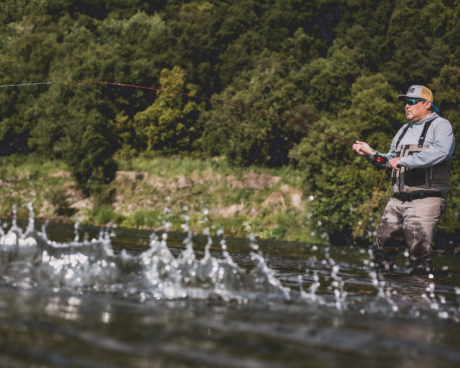So you got a Spey rod. Awesome! Now you looking to find the right line set up for your Spey rod. Whether you’re new to Spey fishing or a seasoned veteran, selecting a line set up to match your Spey rod can be a daunting task, especially with the variety of lines on the market today. You can ask your local shop, Spey guru or you can go online and then find yourself traveling down the rabbit hole of opinions and thoughts. It can be confusing. So, what you need to do before you do any of that, is read about the different styles of Spey style lines and get a fundamental understanding of the different types. When you have an idea of what each style line is designed to do, this will help you choose what style fits you and the type of fishing you want to do. Ultimately, selecting a line for your Spey rod is a personal choice for every angler when it comes down to it. No one person is wrong in their opinion because they use what works for them. So let us break down the three basic styles of Spey lines and what they are designed to do.

Traditional Series Lines: Traditional series lines are the originals. These were the first style of lines that came to market with the Spey rod. Traditional lines come in Mid Belly 52′-60′ and Long Belly 64′ -70′, then there is a new style out from Rio called the Short Head Spey 40′ -50′ (this is where the old meets new). One advantage that all these lines have is less stripping. The longer heads are exactly that, longer, therefore, you have less stripping to get your head in position for your recast. George Cook calls it E-FISH-ENT angler, less stripping means more fishing. Typical casting styles with these lines are the snake roll, single Spey, and Double Spey. The tapers in these lines work well with your classic salmon/steelhead streamers and some have the ability to do some light sink tip work, but don’t put on your 12′ of T-14. While now you have less stripping to do, you do have to ensure you have plenty of room for a backcast. These long heads require some room for their much bigger D-loops.
Scandi Lines: Scandi is short for “Scandinavian.” Obviously, we know where this style came from. The original Scandi lines were 32′-40′ but now there is a version out that brings it down to 22′ (these short lines are designed around the trout Spey game). Scandi casters tend to use faster action rods and use a short quick stroke, casting more off the tip of the rod. This style creates laser-tight loops and is beautiful to watch. Single Spey, snake roll, single and double Spey casts all work with these lines, however single Spey (touch and go) is most common. When you want to do a single or double Spey, a versi or poly leader on the front will help give the line a little better stick for a better-sustained anchor cast. The tapers in these lines work best with smaller flies. They do not turn bigger flies over well. Have a set of versi or poly leaders in your pack and you can do some sink tip swinging as well. Rio makes a Scandi Versi Tip that comes with a set of tips designed for the line, this is another great option as well. Being a longer line, you once again need some backcast room for a bigger D-loop. Key thing to remember with these lines, fly size is critical.
Skagit Lines: The name Skagit (pronounced ska-jit) originates from the Skagit River in Washington State. During the 1990s a contingent of popular Spey casters (Ed Ward, Jerry French, Mike Kenny, Scott O’Donnell, Scott Howell, Mike McCune, Harry Lemire, and others) was at the forefront of the Skagit line development. Skagit lines are designed to cast in tight spaces, turn over big flies with the use of heavy sink tips. This line delivers the meat and potatoes plus desert. Skagit lines range from 11′ to 28′ in length and are available in a head only or integrated with a running line. Head-only lines require a running line, whether it is a coated or mono running line (more to come on this). Single Spey, Double Spey, Snap-T, Snap-Z, Wombat, C-Spey, and Perry Poke are all common casts used with Skagit lines. Skagit lines are very common for the Pacific Northwest, Canada, and Alaska. Skagit heads will turn over a wide variety of sink tips, from 10′ TS to 15′ T18. Keep in mind that the grain weight of the head is going to dictate how heavy of a tip the line can handle. Skagit heads require a tip of some sort. The front tapers are intentionally designed short so they need something on the front to smooth out the turnover. While Skagit lines are designed for bigger flies and fly size, weight is still a factor. The rod must have the power to pull the fly from the water (remember it is on a sink tip sinking), turn it over, carry it, and turn it again.
So, there you have it. A basic rundown of the different styles of Spey lines. If you’re still not sure, contact your local fly shop. Most fly shops have a “Spey specialist” that can help you decide. Also, ask if they offer demo lines that you can borrow and try. That is the best way to identify what kind of line works best for you, by actually trying it out. Stay tuned when we break down Switch lines and the pros and cons of different types of running lines.
More on Two-handed fly fishing:
Leave a Reply